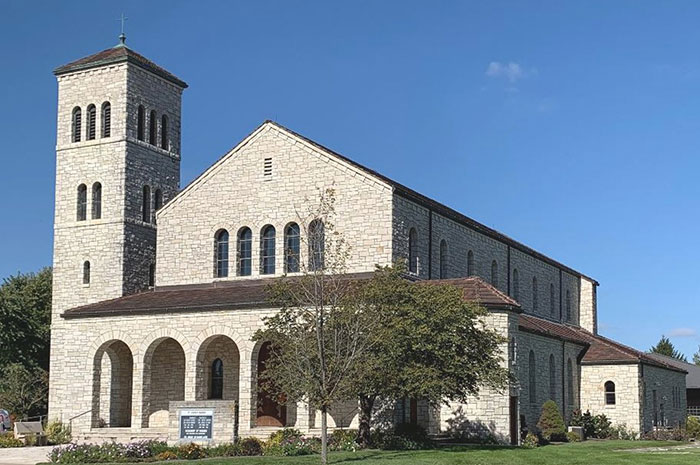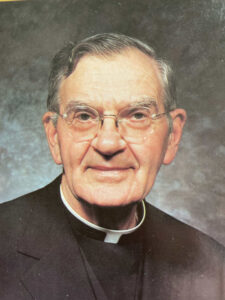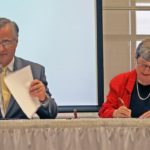
St. John the Baptist Church in Houghton.
By Donna Marie Meierotto Seuferer
For The Catholic Messenger
Father Albert R. Goetzman, a former pastor of St. John the Baptist Parish in Houghton many years ago, dedicated his life to the Church. Many loved him, some underappreciated him, but all

respected him. He was a no-nonsense, traditional character who took his vocation most seriously. Top beneficiaries included his parishioners during Father Goetzman’s 37 years as the Houghton parish’s pastor.
The Cathedral on Highway 16
Father Goetzman arrived just weeks after a fire destroyed the church in the winter of 1944. The business of rebuilding was not delayed. Father penciled out designs for a Romanesque stone structure, one built to last — an idea influenced by his Roman collegiate formation at Vatican colleges where he earned doctorates in theology and philosophy.
He had longevity in mind, not only in terms of construction but also of the church’s eternal value as “the House of God and the gateway to heaven for many generations to come” (from his dedication Mass homily, June 1951).
The intelligent and enthusiastic shepherd utilized his resourcefulness and farm-boy work ethic during war-time shortages. Mindful of economy and efficiency, the project employed only a handful of craftsmen. Parishioners contributed time and talent (a throwback to the days of raising the world’s great cathedrals). Two professional masons were hired. They trained Father in their craft. His work matched their level by the end of their two-year stay. He wore out eight pairs of overalls in the seven years it took to complete the stately structure colloquially dubbed the “Cathedral on Highway 16.”
The sustainable design helped minimize maintenance. Father used a clear voice and effective pauses to broadcast his powerful voice throughout the church’s acoustically sound interior. The tall stone structure defended against heat in summer. The lack of restroom facilities went virtually unnoticed back in the days of longer periods of fasting.
Father credited the angels’ protection for the perfect safety record during the long construction process. While he was building the tower, an onlooker saw him fall from the scaffolding. He picked himself off the debris-covered ground, shook himself off and made nothing more of it. The rectory, added later, incorporates the same Lannon stone used for the church. A glass hallway connects the two.
A diagnosis of a terminal illness forced Father Goetzman to retire in January 1982. He moved across the street from the church, in such close proximity that he might have heard the choir practicing the Latin liturgical music he selected for his funeral.
The Inscription
Upon his death, a colleague wrote a touching tribute to the man he admired for his theological acuity and veracity, which was published in The Catholic Messenger, dated July 15, 1982. It begins:
“It would be most unlikely to find his name inscribed any place except in the parish records, but no person has ever left his mark on a parish or a community like Father Albert Goetzman. He literally built the church and rectory in Houghton. He laid all the stone for the three-story bell tower of St. John church. The design of the two buildings reflects the strength and character of the man who lived and served there.”
The tribute was accurate except for one point: Father Goetzman’s name is clearly displayed, by the work of his own hand, chiseled on the wall in the sacristy. His name is followed by his title in Latin, “SACERDOS DEI ALTISSIMI” (Priest of God Most High). Underneath his name is a verse etched in smaller script, which translates: “You toiled well for me Albert. What shall I pay you in return? — Voice of Christ — April 28, 1951.”
While there is no absolute proof that Father heard God’s voice, many people who remember Father believe in the possibility that he truly heard the voice of Christ in 1951, affirming his pleasure regarding the newly constructed church. Without documentation, Father quietly left it to the mind of the faithful and trusted the timing of the discovery of the inscription to “Dei Altissimi” (God Most High).











